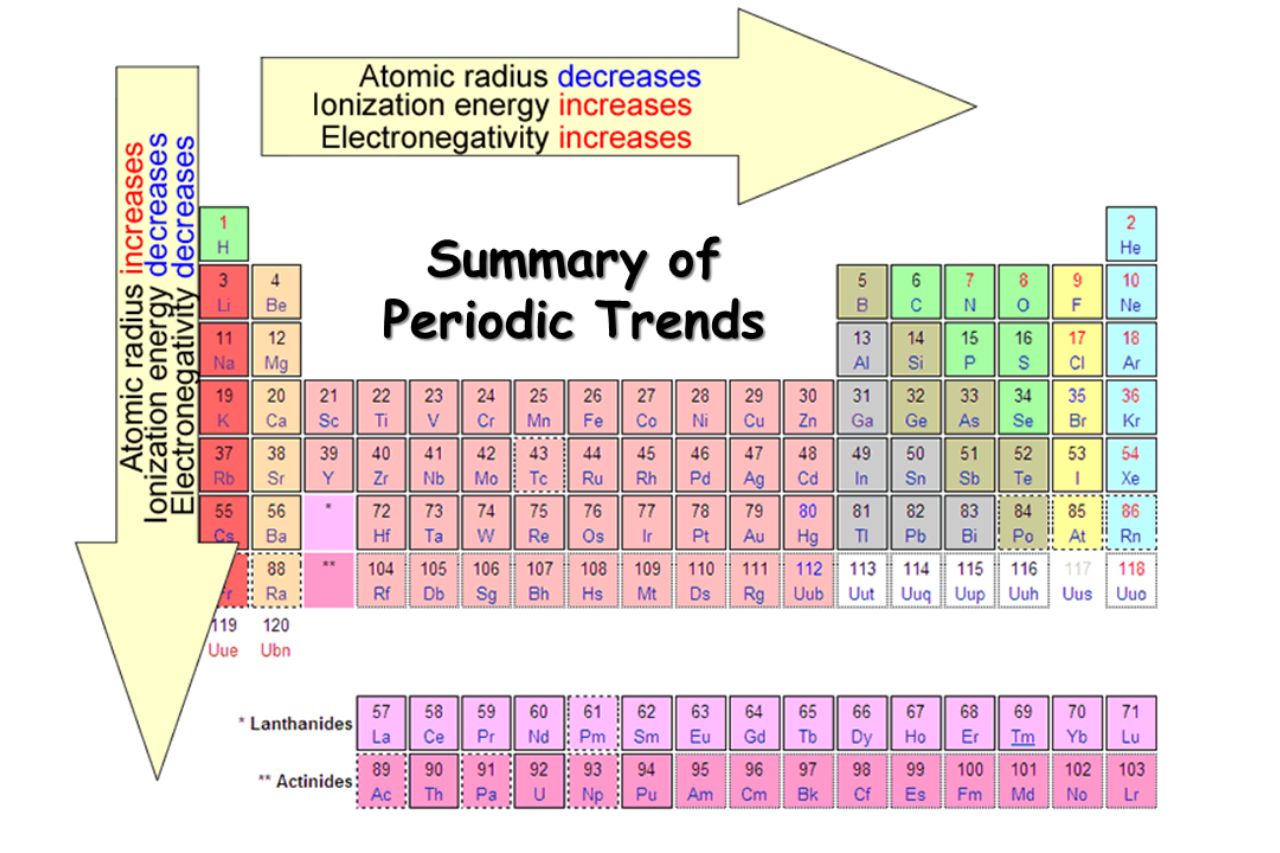
The periodic table is a fundamental tool in the field of chemistry, organizing elements based on their atomic number, electron configuration, and recurring chemical properties. But did you know that within this table, there are fascinating patterns and trends that govern the behavior of elements? These periodic trends provide crucial insights into the behavior of atoms, ions, and molecules, helping chemists predict how different elements will interact and react with each other. In this article, we will uncover 11 unbelievable facts about periodic trends that will leave you in awe of the complexities and wonders of the chemical world. From atomic radius and ionization energy to electronegativity and chemical reactivity, these periodic trends shape the very foundation of our understanding of the elements. So, get ready to dive deep into the world of periodic trends and unlock the mysteries that lie within the periodic table.
Key Takeaways:
- Dive into the periodic table and uncover the amazing patterns that help scientists predict the behavior of elements, from atomic size to reactivity.
- Discover how the periodic table’s secrets extend beyond the table itself, influencing the behavior of compounds and allowing scientists to make predictions in chemistry.
The Periodic Table is a Masterpiece of Organization
The periodic table is more than just a jumble of elements. It is a meticulously organized masterpiece that arranges elements in order of increasing atomic number and groups them based on their similar properties. This arrangement allows scientists to easily identify trends and relationships between elements.
Atomic Size Decreases Across a Period
As you move from left to right across a period in the periodic table, the atomic size of elements decreases. This trend can be attributed to the increasing effective nuclear charge, which pulls the outermost electrons closer to the nucleus, resulting in a smaller atomic radius.
Electronegativity Increases Along a Period
Electronegativity is the measure of an atom’s ability to attract electrons in a chemical bond. Along a period, electronegativity tends to increase due to the higher effective nuclear charge and the reduced atomic size. This trend plays a crucial role in predicting the behavior of chemical reactions.
Ionization Energy Increases Across a Period
Ionization energy is the energy required to remove an electron from an atom. As you move across a period, ionization energy generally increases due to the stronger attraction between the positively charged nucleus and the outermost electron. This trend explains the stability of noble gases, which have high ionization energies.
Metallic Character Decreases Across a Period
Elements on the left side of the periodic table tend to exhibit metallic characteristics such as luster, conductivity, and malleability. However, as you move across a period from left to right, the metallic character decreases. This is due to the increasing electronegativity and decreasing atomic size, which make it harder for elements to lose electrons and exhibit metallic properties.
Group 1 Elements Are Highly Reactive
The elements in Group 1 of the periodic table, also known as alkali metals, are notorious for their high reactivity. They have a strong tendency to lose their outermost electron and form positive ions. This reactivity increases as you move down the group, with cesium being the most reactive element.
Transition Elements Have Unique Spectral Colors
Transition elements, found in the d-block of the periodic table, exhibit fascinating spectral colors. This is due to their partially filled d orbitals, which allow them to absorb and emit specific wavelengths of light. For example, copper compounds appear blue/green, while potassium compounds emit a lilac flame.
Electronegativity Decreases Down a Group
While electronegativity generally increases across a period, it decreases as you move down a group in the periodic table. This is because the electrons are further from the nucleus in higher energy levels, resulting in a weaker attraction to the positive charge. This trend is observed in the halogens, where fluorine is the most electronegative element.
Atomic Radius Increases Down a Group
As you move down a group, the atomic radius of elements increases. This can be attributed to the addition of energy levels or shells, which increases the distance between the outermost electrons and the nucleus. The increasing atomic radius contributes to the reactivity of elements within a group.
Noble Gases Are the Ultimate Party Poopers
Noble gases, located in Group 18 of the periodic table, are known for their low reactivity. Their full complement of valence electrons makes them extremely stable and unlikely to form compounds with other elements. This lack of reactivity earns them the title of the ultimate party poopers.
Periodic Trends Extend Beyond the Periodic Table
The patterns and trends observed in the periodic table also extend to other areas of chemistry. For example, the solubility of compounds tends to follow similar trends based on the nature of the elements involved. These trends allow scientists to make predictions and understand the behavior of various compounds.
In conclusion, the 11 unbelievable facts about periodic trends highlight the fascinating nature of the periodic table and its role in understanding the behavior of elements. From the organization of the periodic table to the trends in atomic size, electronegativity, and reactivity, these facts shed light on the hidden secrets of the elements. So take a closer look at the periodic table and discover the wonderful world of periodic trends.
Conclusion
In conclusion, the periodic trend is a fascinating concept in chemistry that helps us understand the behavior of elements in the periodic table. From the gradual changes in atomic size to the variation in ionization energy and electronegativity, these trends provide valuable insights into the properties and reactivity of elements.
Through the exploration of the periodic trend, scientists have been able to make significant advancements in various fields such as materials science, pharmaceuticals, and environmental studies. By understanding how elements in the periodic table interact and behave, researchers can develop better catalysts, design innovative materials, and create more effective drugs.
So, the next time you come across the periodic table, remember the incredible facts about periodic trends and appreciate the depths of knowledge that this concept has unlocked in the world of chemistry.
FAQs
Q: What is the periodic trend?
A: The periodic trend refers to the gradual and predictable changes in the properties of elements as they are arranged in the periodic table. These properties include atomic size, ionization energy, electronegativity, and more.
Q: Why are periodic trends important?
A: Periodic trends help us understand the behavior and characteristics of different elements. This knowledge is crucial for various applications in fields such as materials science, pharmaceuticals, and environmental studies.
Q: How does atomic size change across the periodic table?
A: Atomic size generally decreases from left to right across a period and increases from top to bottom in a group. This is due to the varying number of energy levels and effective nuclear charge that influence the size of the atomic radius.
Q: What is ionization energy?
A: Ionization energy is the energy required to remove an electron from a neutral atom. It generally increases from left to right across a period and decreases from top to bottom in a group.
Q: How does electronegativity vary in the periodic table?
A: Electronegativity generally increases from left to right across a period and decreases from top to bottom in a group. It measures an atom’s tendency to attract electrons towards itself when chemically bonded to another atom.
Unraveling periodic trends is just the beginning! Curious minds crave more captivating chemistry facts. Delve deeper into the mesmerizing world of periodicity, where patterns and properties intertwine. Explore the great period table, a treasure trove of elemental insights waiting to be discovered. Embark on a journey through the fascinating realm of chemistry, and let your curiosity be your guide.
Was this page helpful?
Our commitment to delivering trustworthy and engaging content is at the heart of what we do. Each fact on our site is contributed by real users like you, bringing a wealth of diverse insights and information. To ensure the highest standards of accuracy and reliability, our dedicated editors meticulously review each submission. This process guarantees that the facts we share are not only fascinating but also credible. Trust in our commitment to quality and authenticity as you explore and learn with us.


